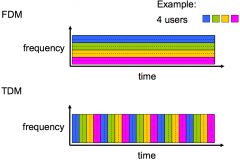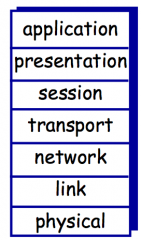![]()
![]()
![]()
Use LEFT and RIGHT arrow keys to navigate between flashcards;
Use UP and DOWN arrow keys to flip the card;
H to show hint;
A reads text to speech;
30 Cards in this Set
- Front
- Back
|
1 kilobyte
|
1024 bytes
|
|
|
1 byte
|
8 bits
|
|
|
Dedicated vs shared
|
Dedicated serves one user
Shared serves multiple users |
|
|
Circuit-switched networks vs packet-switched networks
|
Circuit-switched networks completely dedicate their end-to-end resources to the given task throughout communication between systems, so they have a guaranteed constant transmission rate. No sharing.
Packet-switched networks do not reserve their resources this way - they send data through the net in discrete "chunks," so delays might result. |
|
|
Circuit-switched network TDM vs FDM
|

(time-division multiplexing) vs (frequency-division multiplexing)
|
|
|
When sending a packet over a fixed route, what are the end-to-end delay components? (Name all 4)
|
total nodal delay = processing delay + queuing delay + transmission delay + propagation delay
|
|
|
Throughput for traffic in a network
|
Equal to lowest link. If a path has 3 links of 500kbps, 2Mbps, and 1Mbps, the throughput is equal to 500kbps.
|
|
|
Five layers of the internet protocol stack
|
Application
Transport Network Link Physical |
|
|
Application layer
|
Hold network applications and many related protocols (HTTP for requesting and/or transferring files, SMTP for email, FTP for transferring files between two end systems, SSL, etc.) Another key application-layer protocol, DNS (Domain Name System), works to give Internet end systems more user-friendly names.
|
|
|
Transport layer
|
Data transfer between processes. Deliver messages from the application layer to the other endpoint(s). Uses either the TCP (connection-focused) or UDP (bandwidth-focused) protocols.
|
|
|
Network layer
|
Relays datagrams, or network-layer packets, between hosts. Follows the lone IP protocol to ensure that end systems and routers work to receive datagrams. However, also follows many available routing protocols to decide transport paths between sources. Provides logical communication between hosts.
|
|
|
Link layer
|
Helps the network layer transport a packet from one node to the next. These nodes can include hosts or routers, which are where the link layer takes over from the network layer. These different links may follow different protocols (Ethernet, Wifi, etc.)
|
|
|
Physical layer
|
Within the link layer, the physical layer works to deliver each bit of data across the link. Depending on the link, different protocols might come into play.
|
|
|
Propagation delay
|
distance / time
m / s |
|
|
Transmission delay
|
length of packet / transmission rate
L / R |
|
|
UDP vs TCP
|
UDP (User Datagram Protocol): No-frills and lightweight with minimal services. Connectionless, unreliable, and no handshaking.
TCP (Transmission Control Protocol): Connection-oriented service and reliable data transfer service. Connections limited in their sending rate and bandwidth. |
|
|
The ATNLP internet stack is missing two layers. What are they?
|

Presentation: Allow applications to interpret meaning of data: encryption, compression, machine-specific conventions
Session: synchronization, checkpointing, recovery of data exchange |
|
|
Suppose Alice, with a Web-based e-mail account, sends a message to Bob, who accesses his email from his mail sever using POP3. How does the message gets from Alice's host to Bob's host?
|
The message moves from Alice's host to her HTTP mail server. The server then uses SMTP to transmit the message to Bob's server. Finally, Bob's POP3 server delivers the message to his mail host.
|
|
|
UDP vs TCP sockets
|
UDP = only one socket
TCP = one socket for each new connection |
|
|
ACK vs NAK
|
(Acknowledgement vs Negative Acknowledgement)
ACKs take more time and resources to send, but catch errors sooner |
|
|
IETF
|
Internet Engineering Task Force - helps create internet standards, along with RFCs (Requests For Comments)
|
|
|
What is in the network edge?
|
Hosts (end systems) that run applications such as email
|
|
|
What is in the network core?
|
Interconnected networks: a network of networks
|
|
|
Dial-up modem
|
Use existing telephone infrastructure
Maximum of 56kbps Dedicated |
|
|
Digital subscriber line (DSL)
|
Use existing telephone infrastructure
Typically 256kbps upstream and 1 mbps downstream Shared |
|
|
FTTH
|
Fiber to the home: optical links from central office to home
2-10 Mbps upstream and 20 Mbps downstream Dedicated |
|
|
Which two layers exist in a switch?
|
link and physical
|
|
|
Which three layers exist in a switch?
|
network, link, and physical
|
|
|
RTT
|
Round-Trip delay Time, or time for a small packet to travel to client and back
One RTT to initiate TCP connection One RTT for HTTP request and first few bytes of HTTP response to return |
|
|
Persistent HTTP
Non-persistent HTTP |
Persistent HTTP: multiple objects can be sent over single TCP connection between client, server.
Non-persistent HTTP: at most one object sent over TCP connection. |

